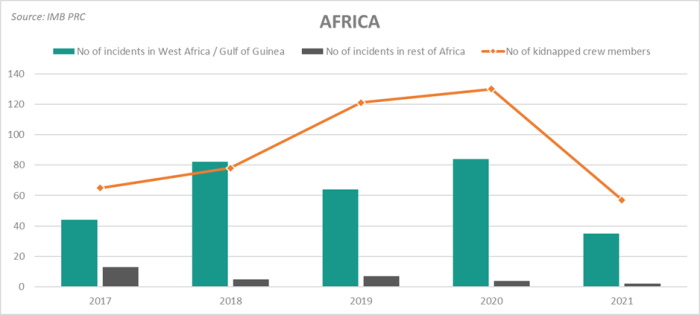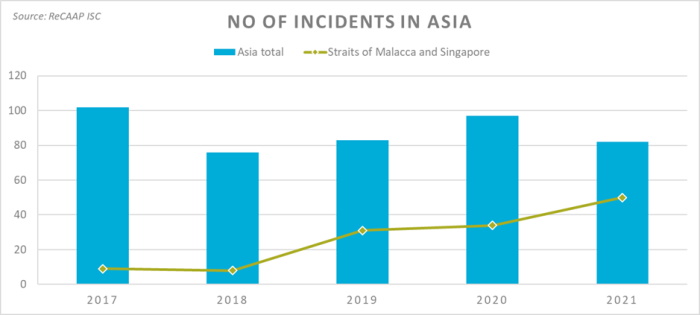Global piracy and armed robbery numbers decreased in 2021, according to the International Maritime Bureau's Piracy Reporting Centre (IMB PRC). Its latest annual report shows a 32% drop in overall attacks in 2021 compared to 2020. The drop is primarily attributed to decreased activity within the Gulf of Guinea region, and Nigerian waters in particular. A look at the figures also reveals that only two incidents were recorded within the African continent outside the Gulf of Guinea region, compared to four in 2020. The Regional Cooperation Agreement on Combating Piracy and Armed Robbery against Ships in Asia Information Sharing Centre (ReCAAP ISC) reported a 15% decrease in the total number of incidents in Asia compared to 2020.
The reduction of reported incidents at regional levels is welcome but major problems persist. The waters off West Africa remains a piracy hotspot. 2021 also saw the trend of armed robberies against vessels in the Singapore Strait continue, and no improvements for robbery incidents in South America. Incident reports from around the world indicate that violence against crew remains high in many areas.
Africa
The increased presence of naval vessels and cooperation between regional authorities in the Gulf of Guinea has had a positive impact on the activity reported within that region – resulting in a 60% drop in recorded incidents compared to 2020. However, despite the decrease of the total number incidents in the Gulf of Guinea in 2021, the IMB PRC warns that the threat to innocent seafarers persists. Like in 2020, the region accounted for all kidnapping incidents globally, with 57 crew taken in seven separate incidents in 2021. Several crews were also taken hostage or injured in the region, with one crew member killed.
The IMB PRC's figures indicate that, overall, incidents in the Gulf of Guinea are fairly evenly split between vessels steaming and vessels at anchorage/berth. As shown in the table below, the majority of kidnapping incidents still occur while vessels are steaming and can take place at great distances from shore.

Nigeria recorded no kidnapping incidents in 2021 with the total number of incidents in its waters dropping more than 80% compared to 2020. The country remains one of the top five locations for incidents recorded in the Gulf of Guinea in 2021, together with Ghana, Sao Tome and Principe, Angola, and Gabon. It is also worth noting that both Luanda Anchorage, Angola, and Conakry Anchorage, Guinea, featured in the IMB PRC's list of “Ports and anchorages with three or more reported incidents in 2021”. That trend may be continuing into 2022 as the IMB PRC reported three armed robbery incidents from Luanda Anchorage during the first six weeks of 2022.

With only one incident reported from the Somali Basin and Gulf of Aden in 2021, the threat of attacks from Somali based pirates appears to have decreased. This was also reflected in the revision and reduction of the ‘High Risk Area’ in September 2021.Nevertheless, Somali pirates retain the capability and capacity to carry out attacks and the IMB PRC continues to encourage Masters operating in the region to be vigilant, particularly when transiting close to the Somali coast. Although not piracy related, maritime security in the Southern Red Sea, Bab al-Mandeb and Gulf of Aden is also affected by the ongoing conflict in Yemen – a conflict that is primarily land based but where direct or collateral damage to merchant vessels operating in the region cannot be ruled out. Please refer to our Yemen website for additional information.
Asia
According to ReCAAP ISC, 82 incidents were reported in Asia in 2021, compared to 97 in 2020. All falling with the ‘armed robbery’ category. While most locations in Asia experienced a reduction in reported incidents, a sustained increase in the recorded rate of incidents in the Singapore Strait continues to give cause for concern. ReCAAP ISC draws attention to the levels of violence used by the perpetrators towards the crew in incidents at Manila Anchorage areas in the Philippines. It also reminds the industry not to forget about the persisting threat of abduction of crew in the Sulu-Celebes Seas area.

• Singapore Strait: A total of 49 piracy incidents were recorded in the Singapore Strait in 2021, compared to 34 in 2020. The majority of these occurred in the Strait's eastbound lane, with bulk carriers the most frequently targeted ship type. Although crew were not harmed in the majority of these incidents, it is not uncommon for the perpetrators to be armed with knives, gun-like objects, etc. See also our alert Continued piracy activity in Singapore Strait of 13 July 2021.
The negative trend in the Singapore Strait seems to continue into 2022. Ten incidents were reported from ships underway in the Singapore Strait between 1 January and 21 February 2022, seven of these from the eastbound lane. “Since the perpetrators are not arrested, there is a possibility of continued occurrence of incidents in the Singapore Strait”, warns ReCAAP ISC in its Incident Alert of 21 February 2022.
• Manila Anchorage, Philippines: A total of nine incidents were reported at Manila Anchorage areas in 2021. All took place during the hours of darkness, and seven of the nine involved a container vessel. As highlighted in our alert “Thefts and robberies in the Philippines” of 29 September 2021, ReCAAP ISC expresses concern about the increase in the violence demonstrated by the perpetrators towards the crew in many of these incidents. On the positive side, ReCAAP ISC has received no incident reports from the Manila Anchorage area since September, after the Philippine authorities arrested several members of a criminal group responsible for the incidents in the area.
• Sulu-Celebes Sea and eastern Sabah region: No incidents of abduction of crew for ransom have been reported in these waters since January 2020. However, ReCAAP ISC warns that the threat remains high as the as the leaders of the Abu Sayyaf Group who were responsible for the past abduction incidents are still at large. Additional advice is also provided in our alert Crew abductions in South-East Asia of 11 November 2021.
South and Central America and Caribbean waters
With a total of 36 piracy and armed robbery incidents recorded in the South and Central America and the Caribbean waters in 2021, the IMB PRC's five-year statistics shows no improvements for this region. Six crew were threatened, four taken hostage, and two assaulted in the region in 2021, according to the IMB PRC. Two container ships were also approached and fired upon during their river passages in Ecuador in the last quarter of 2021.
The Callao Anchorage in Peru has been considered a robbery hotspot for many years and 2021 was no different. 18 incidents were recorded in this Peruvian anchorage in 2021, more than double the number in 2020, and the trend reportedly continues into 2022. Worth noting is also the year-on-year increase in incidents reported in Colombia, and the country is once again featuring among the top five locations for incidents recorded in South America in 2021.

Stay alert
The level of threat from piracy and armed robbery at sea, as well as the opportunity for and modus operandi of the perpetrators, differs from one region to another and may also change quickly. Prior to entering any piracy prone area, it is important to obtain updated information from local sources and security experts, review the ship security plan in light of the information received, conduct a voyage specific risk assessment, brief and train the crew and prepare and test the ship’s emergency communication plans. Relevant preventive measures must be adopted, following available industry guidance and best management practices (BMP), such as the BMP West Africa, BMP5, Regional Guide to Counter Piracy and Armed Robbery Against Ships in Asia and Global Counter Piracy Guidance for Companies, Masters and Seafarers. The potential consequences of not following industry best practices may be severe when transiting areas prone to piracy.
As ships may be particularly vulnerable when at anchor, ship masters and crew should exercise extra vigilance when staying at high-risk ports/anchorages. Remember that a proper lookout is considered one of the most effective methods of ship protection. It can help identify a suspicious approach or attack at an early stage, allowing defences to be deployed.
Source: Gard
The opinions expressed herein are the author's and not necessarily those of The Xinde Marine News.
Please Contact Us at:
media@xindemarine.com





 Ningbo Containerized Freight Index Weekly Commentar
Ningbo Containerized Freight Index Weekly Commentar  Ningbo Containerized Freight Index Weekly Commentar
Ningbo Containerized Freight Index Weekly Commentar  Ningbo Containerized Freight Index Weekly Commentar
Ningbo Containerized Freight Index Weekly Commentar  BIMCO Shipping Number of the Week: Bulker newbuildi
BIMCO Shipping Number of the Week: Bulker newbuildi  Ningbo Containerized Freight Index Weekly Commentar
Ningbo Containerized Freight Index Weekly Commentar  Ningbo Containerized Freight Index Weekly Commentar
Ningbo Containerized Freight Index Weekly Commentar